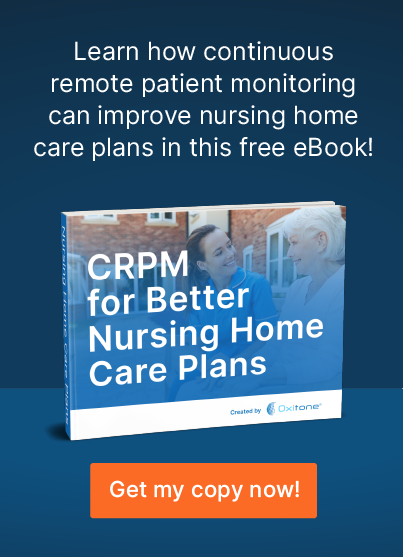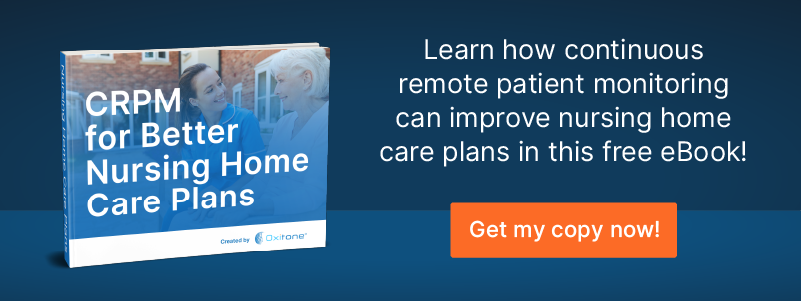Benefits of using Oxitone’s comfortable wearable medical device for real-time insights and preventing patient complications
Monitoring Patients at Home and across the Globe
Despite our best efforts as clinicians, some hospital readmissions are necessary and unavoidable. Cardiac and pulmonary patients can develop unusual complications after surgery, like incision site infections or fluid around heart tissues. Other patients show up at the emergency room with vague symptoms, like dizziness or transient low blood pressure, which could have been easily and effectively treated without costly hospitalization.
Each year, the United States spends about 75% of its $2-trillion budget on chronic diseases, which cause seven out of every ten deaths. Monitoring chronic obstructive pulmonary disease and chronic heart failure is one of the most complex and costly challenges to the healthcare system — and it can mean life or death for patients with chronic cardiac and pulmonary disease.
Our patients need prompt responses. Physicians need easy and timely follow-up methods. Continuous physiological monitoring technologies have advanced and now have the ability to improve patient outcomes. To realize the potential of these technologies, we need patient data and predictive insights without complex interfaces. We need information that is just a button click away.
The Promise and Limitations of Traditional Remote Patient Monitoring (RPM)
Innovations in medical wearable devices for RPM can keep costs manageable while giving physicians immediate access to patient data and clinical insights. The use of medical wearable devices for remote monitoring has been shown to reduce emergency room visits by 68%, with 35% fewer patients requiring costly hospitalization.
Traditional remote patient monitoring devices have been plagued by poor patient compliance and unreliable measurements during daily activities, like running or walking. First-generation heart monitors had large, uncomfortable chest straps that wrapped completely around the body. Even now, most pulse oximeters require obstructive finger probes that are not reasonable for continuous monitoring during routine daily activities. It is no surprise that patients are unwilling to regularly use these bulky wearable devices that interfere with normal movement, have short battery life, and look like medical equipment.
Earlier generations of medical wearable devices for patient monitoring were also sensitive to motion. So, normal daily activities, like running, exercise, and even typing, could mean missing or inaccurate measurements. However, modern advancements like embedded sensors, increased processing power and battery life, and Bluetooth communication have improved photoplethysmography (PPG), the optical technology that allows for non-invasive physiologic measurements directly from the skin surface.
Continuous monitoring of vital parameters, including heart rate, SPO2, and respiration rate, depend on how well PPG technologies take measurements not only at rest but also during motion. The latest technologies can account for motion with multiple sensor signals, smart artificial intelligence enhancements, and algorithmic correction of motion artifacts.
We have improved sensor technology, but will patients use it? Moreover, will it become part of a patient’s routine for ongoing compliance?
Wrist-Worn Wearable Devices Are the Next Generation of Patient Monitoring
Modern patients are accepting and even excited about wearable devices. In 2020, one in five adults (21%) in the United States already uses a smart watch for tracking their health, according to Pew Research. More than half said that they supported using a wrist-worn wearable device data for medical and research purposes. Now is the time to bring medical wearables into the modern era with a form factor that is sleek, convenient, and comfortable for work and play.
The Oxitone® AI-powered RPM simply slips on your patient’s wrist, where it records multiple parameters in real time. Oxitone’s patented Ulnar Bone FlexSense™ is a breakthrough technology that uses multiple flexible trans-illumination optical sensors, which let it copy and follow the unique topography of each patient’s wrist ulna bone. That means it is comfortable and familiar to patients. It also has more accurate measurements, even when working or exercising.
Oxitone lets patients and physicians say goodbye forever to bulky fingertip probes and hello to continuous and convenient data from wearable devices. As the first FDA-cleared and CE-marked wrist-worn patient monitor, Oxitone is a transformative solution for measuring physiologic parameters as patients go about their daily activities.
Easy for Patients, Reliable for Physicians
Clinical trials have shown that Oxitone devices are both accurate and precise for monitoring SpO2, pulse, and other parameters during routine daily activities. This is data that physicians can trust.
Patients and caregivers can enjoy real-time access to coded notifications, biomarkers, and symptoms self-assessment that improve compliance. In clinical trials, more than 97% of patients found Oxitone devices easy to use, clear, and readable.
Physicians are also able to easily access their patient data anytime and anywhere by simply navigating to the user-friendly SaaS clinician’s portal. You can follow up with 1,000 patients in just one click.
Modern Patients Require Modern Solutions: Oxitone Advances COVID-19 Care
Pulse oximetry (SpO2 and pulse rate) are important monitoring tools in ambulatory patients with pulmonary disease. With minimal contact, continuous monitoring is most important for recovering COVID-19 patients in the outpatient setting. Oxitone provides a user-friendly solution for reliable and safe monitoring.
Using Oxitone’s medical wearable devices, “silent hypoxia” in COVID-19 and ambulatory pulmonary patients can be detected early with Oxitone technology, while optimizing healthcare professional workflow. Now, when remote patient outcomes are more important than ever, telemedicine providers are trusting Oxitone to improve outcomes for our most vulnerable patients.
Here at Oxitone, we boost value-based healthcare by delivering extraordinary patient, clinical, and economical outcomes at reduced medical utilization and cost. Patients need a prompt response to emergencies. Physicians need an easy and timely follow-up with patients. Our mission is to transform chronic disease management and help save lives worldwide.
Let’s save lives together! To see how we help remote patient monitoring companies and physicians improve the management and care of high-risk patients, contact us today!


